Your Entryway Is Secretly Stressing You Out. Here’s the Fix.
For years, I’ve had a front-row seat to the real story of how a family lives, and it all unfolds in the first ten steps inside their front door. As someone who designs and builds storage for a living, I can tell you that the entryway, mudroom, foyer—whatever you call it—never lies. It’s a zone of quiet chaos, isn’t it? That pile of shoes waiting to trip someone, the stack of mail and school papers on the only flat surface, and the keys… well, who knows where the keys are.
In this article
So many people treat their entryway like a museum exhibit. They hang a nice mirror, toss down a pretty rug, and call it done. But that’s like admiring the paint job on a car with a seized engine. An entryway isn’t just for looking at; it’s a machine for living. It’s the critical transition point for you, your family, and everything you haul between the outside world and your home. If that machine is clunky, it grinds to a halt every single day, causing friction and frustration. My job is to get that machine running smoothly.
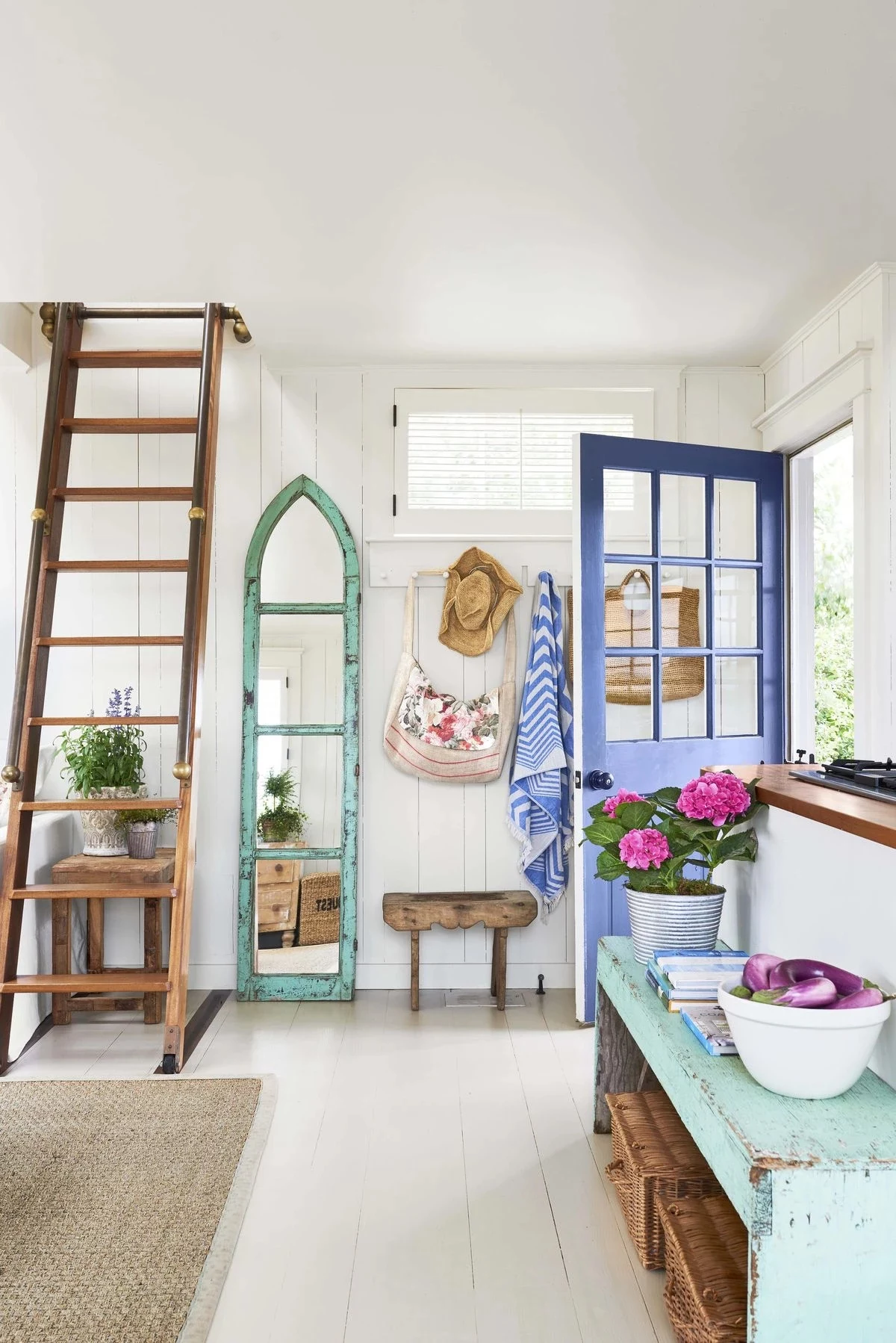
In this guide, we’re skipping the fleeting trends. Instead, I’m sharing the functional framework I’ve used over and over to fix these problem areas. We’ll get into the nitty-gritty of how people actually move, the right materials for the job, and the practical systems that turn a cluttered dumping ground into a streamlined launchpad. This is about making your daily life genuinely easier.
The Unseen Science of a Good Entryway
Before you even think about buying a bench or a hook, it helps to understand the “why.” A great entryway respects two things: how our brains work and basic physics. Psychologically, it’s a space where we shift gears from “public mode” to “private mode.” Walking into a wall of clutter keeps your stress level high. You’re literally dragging the tension of the day inside with you.
Then there’s the physics part, which is all about movement and clearance. The pros use established standards for a reason. You need a clear path of at least 36 inches to walk comfortably. That’s not some random number—it’s the space you need to carry groceries without banging your knuckles or for two people to squeeze past each other without doing that awkward shuffle. I once saw a home where a gorgeous console table was crammed into a 40-inch hall, leaving a gap of only 24 inches. The owners were constantly bruising their hips on it. It looked great in a photo, but it failed the real-life test. So, do yourself a favor: measure your space and protect that 36-inch path at all costs.
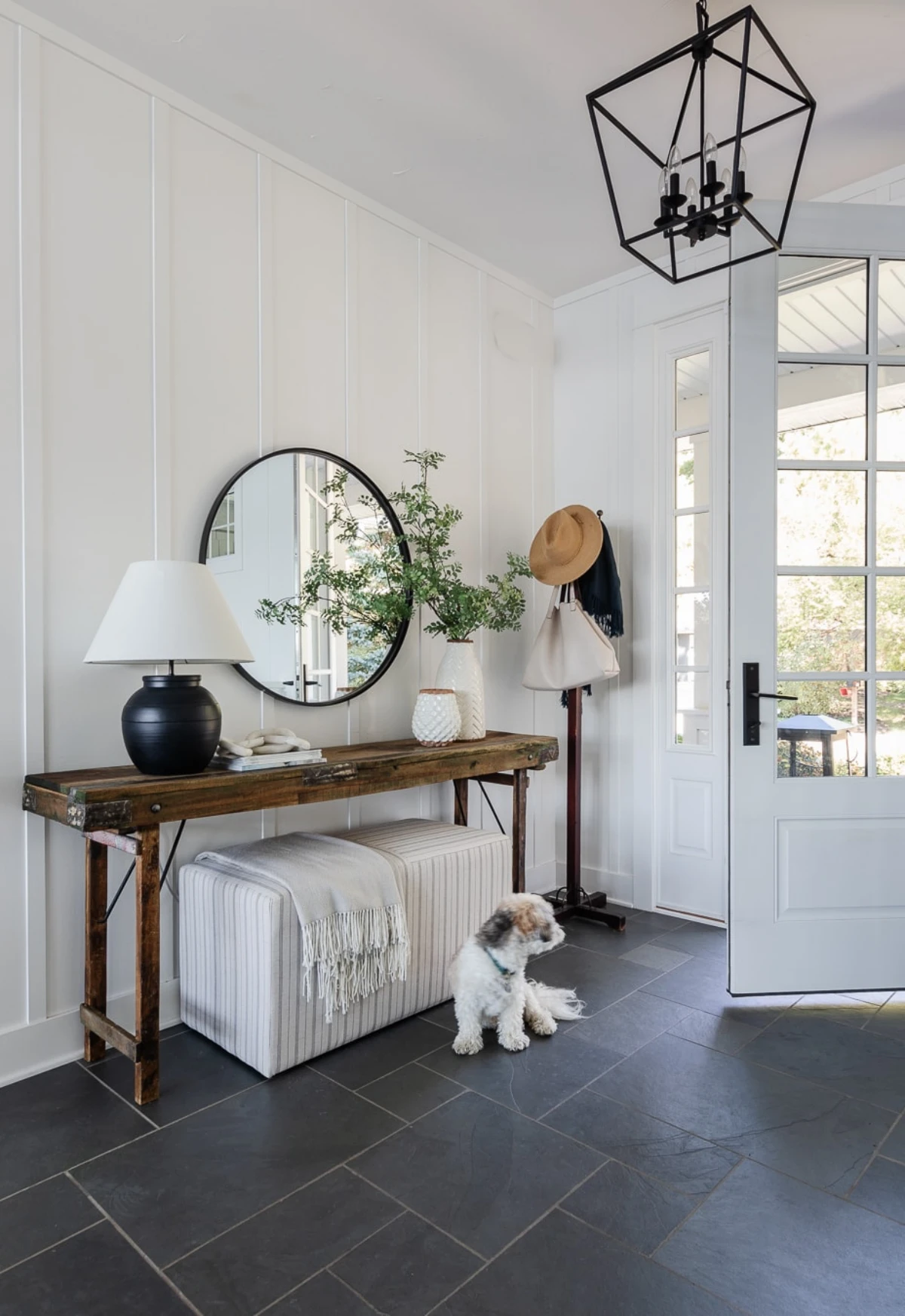
The Most Common Entryway Mistakes (and How to Fix Them for Good)
I’ve seen the same functional mistakes repeated in homes of all sizes. These aren’t failures of style, but of planning. Here are the biggest culprits I’m hired to fix, and the lasting solutions we put in place.
Mistake 1: The ‘Show Home’ Entryway That Fails in Real Life
This is the big one. You choose pieces based on looks, not your actual routine. That delicate antique chair looks amazing, but nobody can sit on it to tie their shoes. That slim, elegant table has legs so fragile you’re scared to even look at it, let alone drop a heavy backpack on it.
The Pro Fix: The 7-Day Entryway Audit
Before you buy a single thing, I want you to try a simple exercise. For one week, just observe your family’s entry and exit habits without judgment. Think of it as a little investigation.
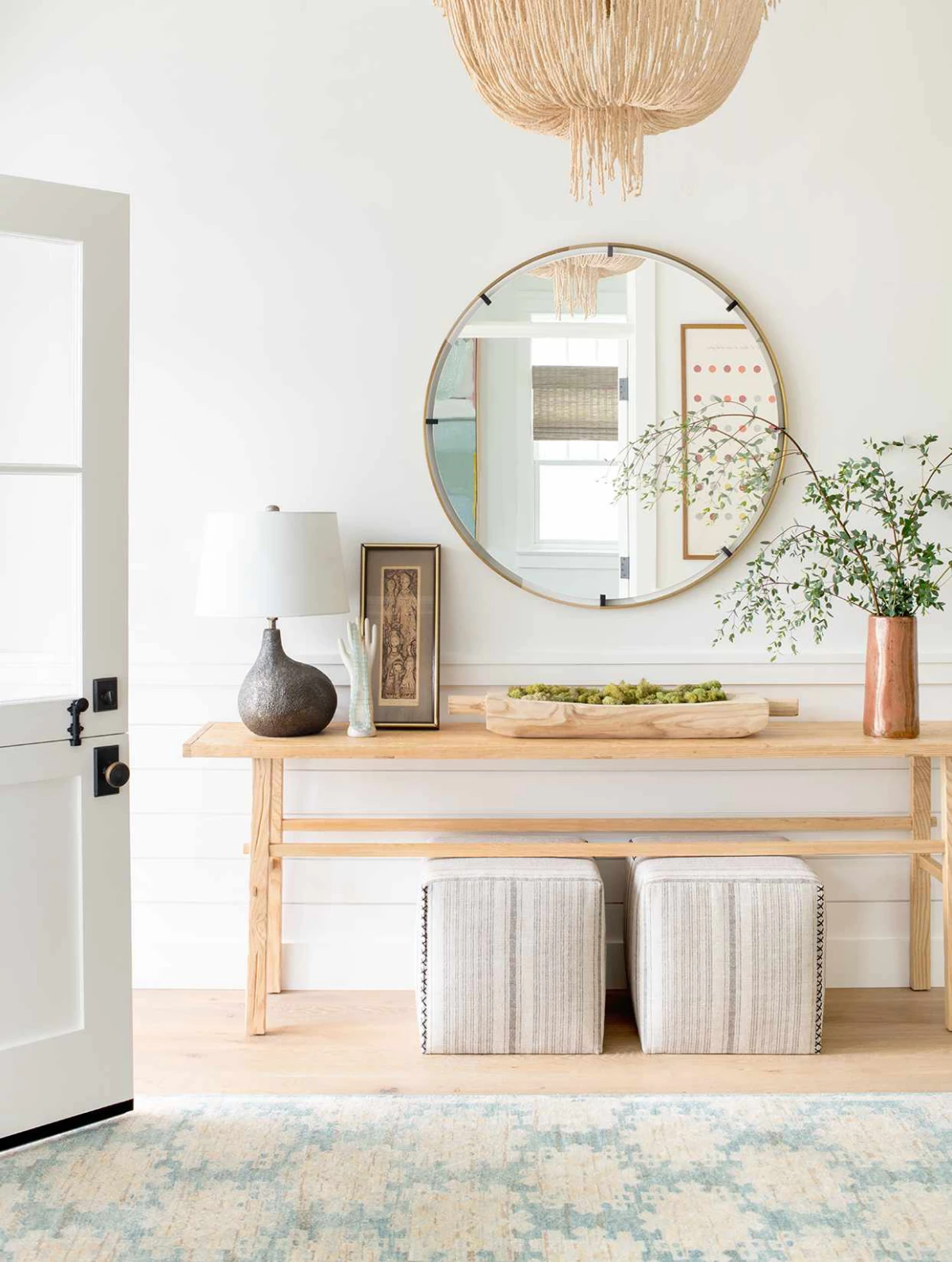
- Coming Home: When you walk in the door, what’s in your hands? Keys, mail, purse, backpack, dog leash? Where do you instinctively want to put it all down? Don’t think about where it should go. Pay attention to your gut reaction. Most people head for the first available flat surface.
- Leaving the House: When you’re heading out, what do you need to grab? Coat, shoes, wallet, gym bag? How much time do you waste hunting for everything?
This little audit reveals what your space really needs. If your instinct is to drop everything on one specific table, that’s your primary “landing strip.” The solution isn’t to fight that instinct—it’s to design for it. Replace that flimsy table with a sturdy one. Add a designated bowl for keys and a tray for mail right there. You’re working with human nature, not against it.
I worked with a family whose kids would dump their massive school backpacks right on the floor. The mom was constantly fighting a losing battle, telling them to take the bags to their rooms. When we watched their routine, we realized the kids were just wiped out after school. The last thing they wanted was another chore. The fix? We installed two heavy-duty hooks right by the door, low enough for the kids to reach. Suddenly, the backpacks had a home—off the floor, and right where the kids wanted to drop them. The battle was over.
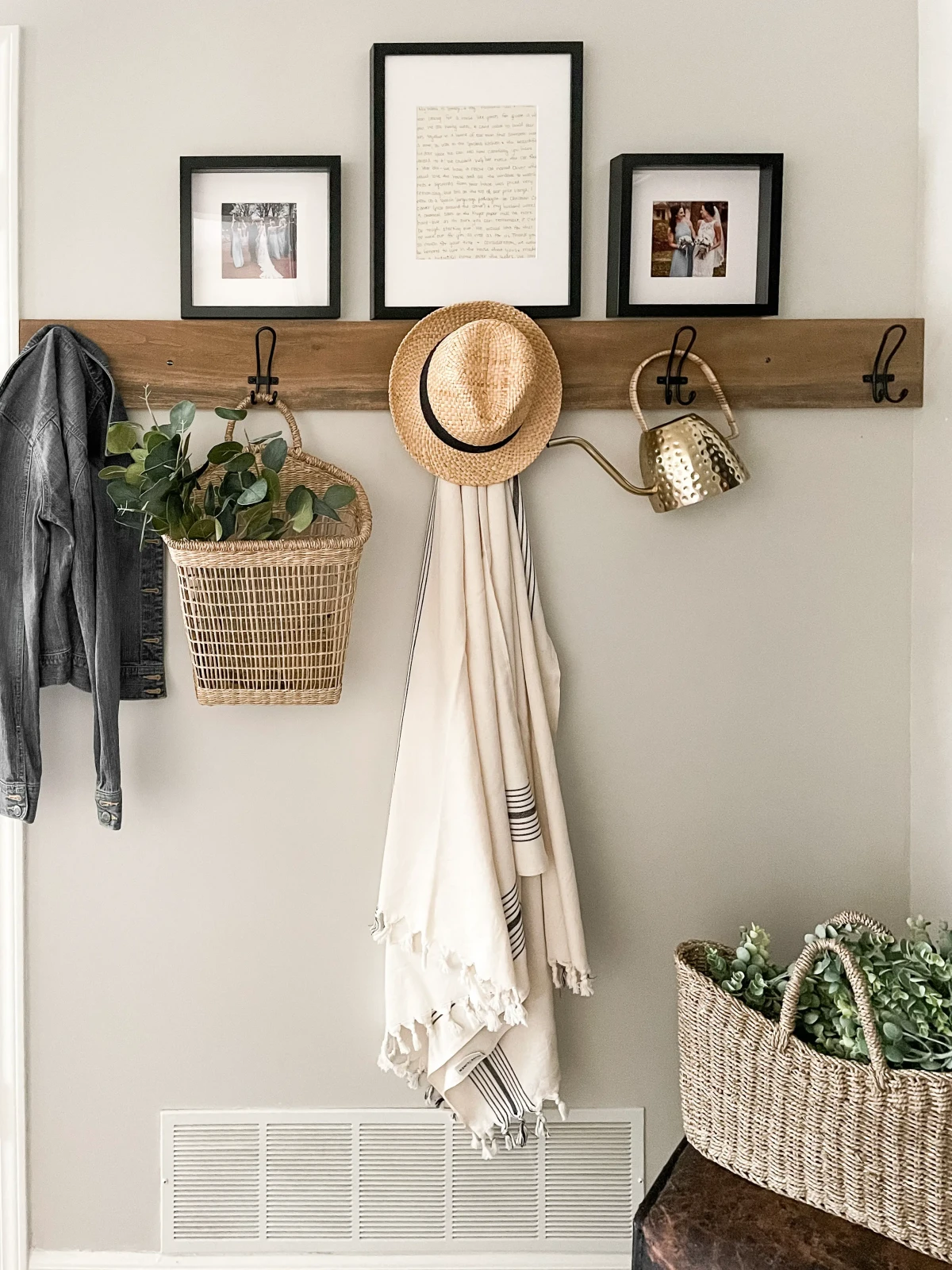
Mistake 2: Forgetting About Your Walls
Most people only think horizontally. They put a shoe rack on the floor, a bench on the floor, maybe a table on the floor… and all this does is create a traffic jam. The most underused asset in any entryway is the vertical space on your walls.
The Pro Fix: Build Up, Not Out
Using your walls is the single best way to reclaim floor space and get organized. But you have to do it safely.
Heads up! A quick note on safety.
I cannot stress this enough: do not hang heavy shelves or hooks with those tiny plastic anchors that come in the box. They are only rated for a few pounds in drywall. A wet wool coat can easily weigh 15 pounds, and a kid’s backpack can hit 20-30 pounds. I once got a call to repair a wall where a shelving unit had ripped clean out of the drywall. It fell in the middle of the night, taking a huge chunk of the wall with it. It was a costly and dangerous mistake.
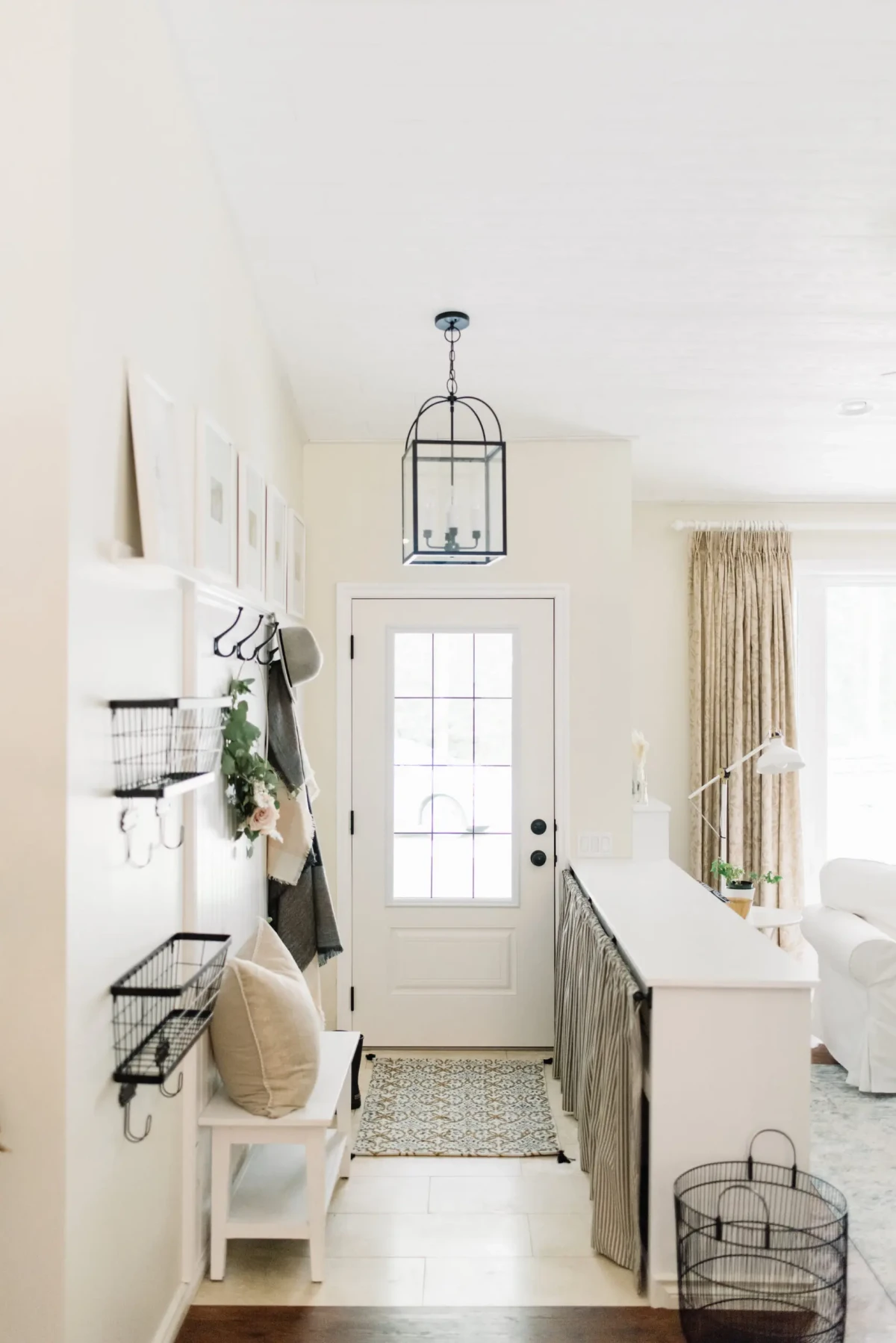
For a truly secure installation, you must anchor into a wall stud. A simple Zircon stud finder from a place like Home Depot will cost you about $20 and save you a world of hurt. They’re usually 16 inches apart. If a stud isn’t in the perfect spot, use a real heavy-duty anchor like a toggle bolt. They look intimidating, but they are lifesavers for hanging heavy items. A quick search on YouTube for “how to use a toggle bolt” will be your best friend, I promise.
A Layered Hanging Strategy:
Once you know how to anchor things properly (which, if you’re new to it, might take an hour or two to get the hang of—time well spent!), you can create layers of storage.
- High Zone (70+ inches): Perfect for a sturdy shelf holding baskets of off-season gear, like winter hats and gloves in the summer.
- Adult Zone (48-60 inches): This is prime real estate for adult coats and bags. A solid plank with multiple heavy-duty hooks is way more versatile than individual ones.
- Kid Zone (30-40 inches): Lower hooks are a game-changer if you have kids. It empowers them to hang up their own stuff and builds good habits.
- Wall-Mounted Landing Strip: In a super narrow hall, a floating shelf can act as your drop zone without taking up a single inch of floor space.
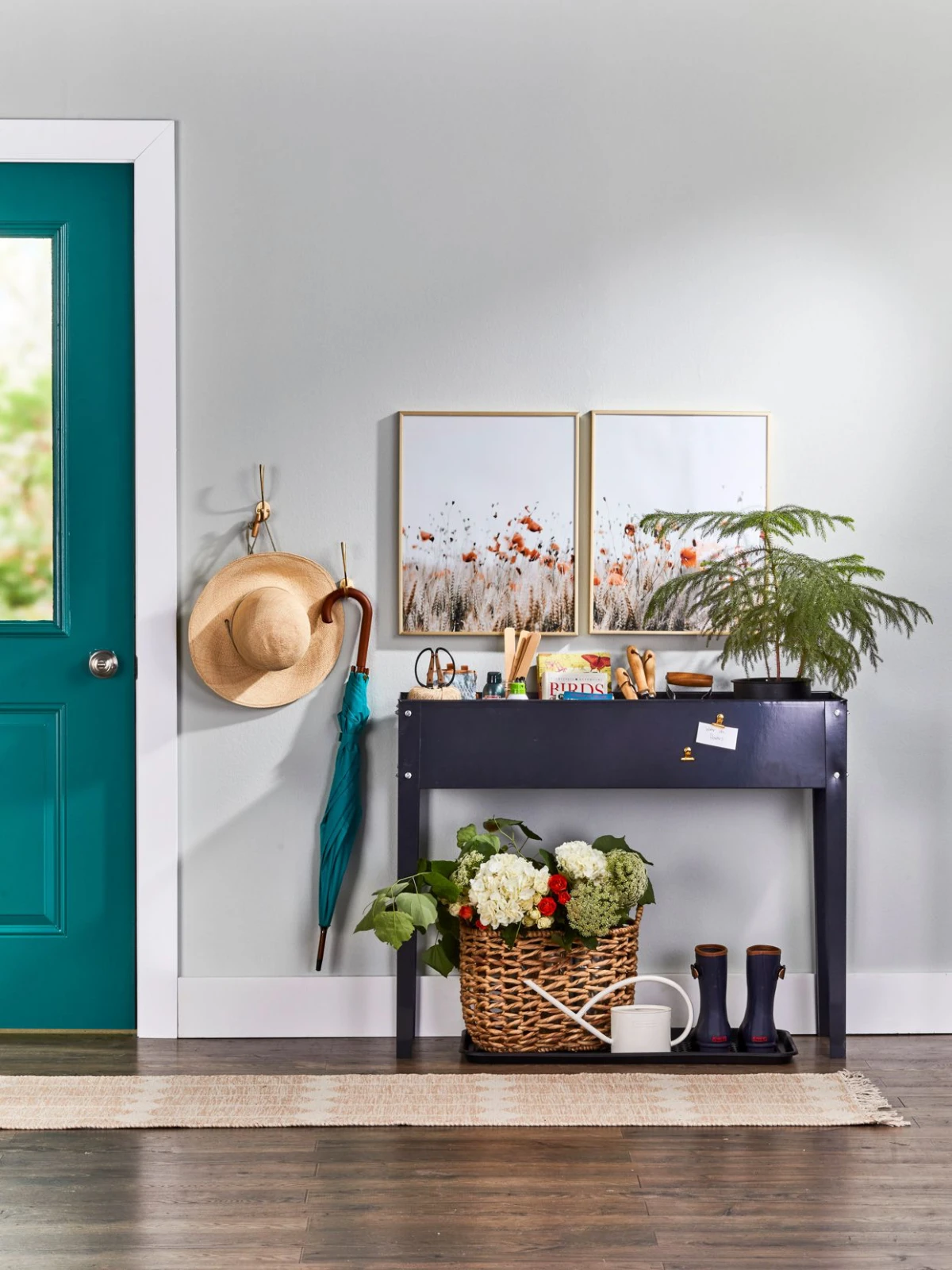
Mistake 3: Furniture That Doesn’t Pull Its Weight
A simple chair is just a chair. In a high-traffic space like an entryway, every single piece should be a multitasker. Single-purpose furniture is a luxury most entryways can’t afford.
The Pro Fix: Demand More from Your Furniture
A storage bench is a fantastic choice because it gives you a place to sit and a place to store. The big decision is whether to go with open cubbies or a closed, lift-top lid.
- Open Cubbies are great for… quick access. They’re perfect for the shoes you wear every day because they’re easy to grab and put away. The downside? You can see the mess. My tip is to use simple, durable baskets in the cubbies to contain the clutter while keeping things accessible.
- A Closed, Lift-Top Bench is better for… hiding clutter completely. When you close the lid, the mess disappears. The catch is that it can become a black hole where things are forgotten. I usually recommend these for less-used items like sports gear or reusable shopping bags. A crucial safety note: if you have little kids, make sure the lid has a soft-close hinge to prevent smashed fingers!
And by the way, material matters. A lot. Your entryway takes a beating from wet boots, salt, and dirt. This is not the place for delicate materials.
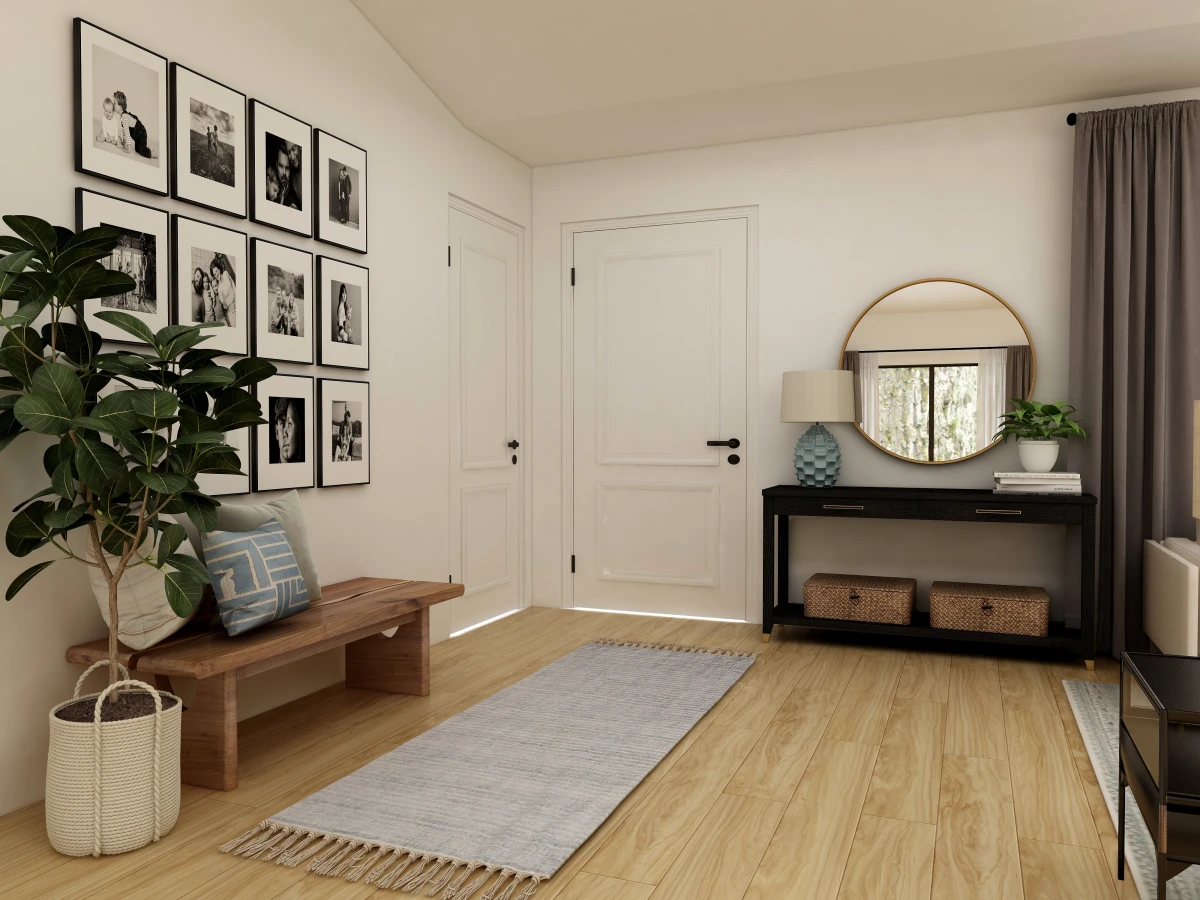
- Solid Wood & Quality Plywood: These are the gold standards for durability. They hold up to moisture and can be refinished if they get scratched.
- MDF (Medium-Density Fiberboard): This is what most affordable furniture from places like IKEA or Target is made of. And while it looks fine new, it’s extremely vulnerable to water. I’ve seen it a million times: the corner of a cheap MDF bookcase that sat near the door swells up to twice its size and looks like wet cardboard after just one snowy winter. It’s okay if your budget is tight, but be prepared for it to have a shorter lifespan.
Mistake 4: Having Gear, But No System
You can have all the right furniture, but you’ll still have chaos without a clear, logical system. It’s all about creating an intuitive sequence for your daily routine.
The Pro Fix: Engineer Your Drop-Off and Pick-Up Sequence
A great entryway guides you through a series of actions without you even thinking. Here’s the five-part system I set up for my clients:
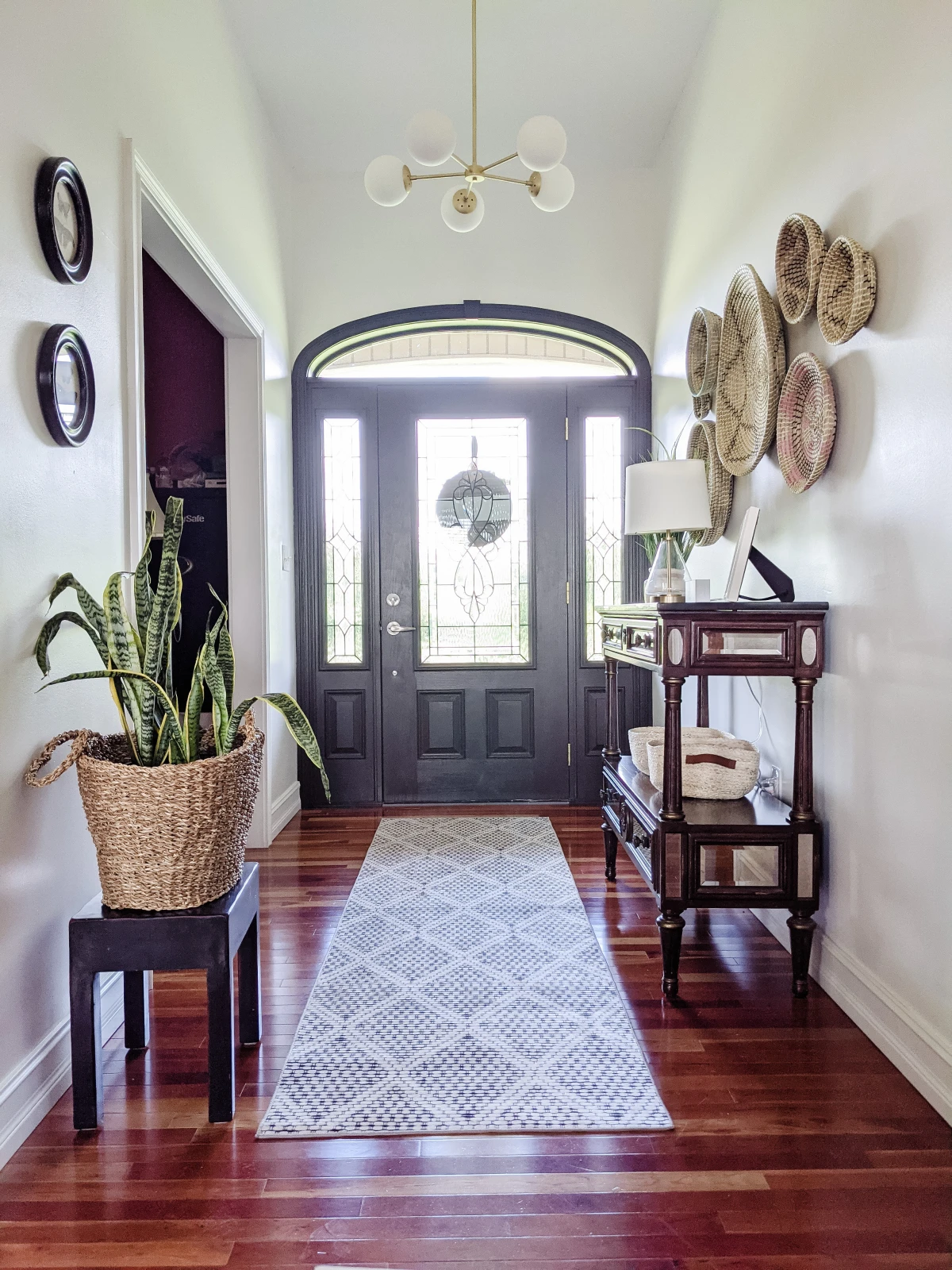
- The Landing Strip: The moment you walk in, you need a spot for what’s in your hands. On a sturdy table or floating shelf, place a small bowl for keys (you can find cool ceramic or metal ones for $10-$25) and a simple mail sorter (usually $15-$40). I’ve also started adding small charging stations here.
- The Unburdening Zone: Right next to the landing strip should be your bench or a sturdy chair where you can sit to take off your shoes.
- The Footwear Dock: Directly under or next to the bench is where shoes live. This could be the bench cubbies, a simple rack, or just a durable, waterproof mat. The key is that you can put your shoes away without taking another step.
- The Outerwear Hub: After your hands are free and shoes are off, deal with the coat. The hooks should be right there. Forcing someone to walk across the room is a recipe for a coat ending up on a chair.
- The Outbox: This is the secret weapon. Designate one sturdy basket or tote as the “outbox” (plan on spending $20-$50 for a good one that will last). Anything that needs to leave the house goes in here: library books, packages to mail, returns. Before you leave, you just grab the whole thing. It ends that frantic last-minute search.
Your Quick Win Today: Don’t feel overwhelmed. Just go find one sturdy basket you already own. Put a label on it that says “OUTBOX.” Place it by the door and put everything that needs to leave the house in it. Done. You just made tomorrow morning 10% easier.
Mistake 5: The Four-Season Clutter Pile
Does your entryway have bulky winter parkas fighting for space with light rain jackets… in July? When your entryway holds every accessory you own, it feels crowded and makes it impossible to find what you actually need.
The Pro Fix: The Seasonal Swap-Out
Your entryway should only hold what you need for the current season. Everything else needs to be stored elsewhere. I tell my clients to schedule this task twice a year, maybe in October and April. It takes about an hour, and it pays you back every single day.
- Pull Everything Out: Empty the entryway completely.
- Sort and Purge: Be honest. If a coat hasn’t been worn in two winters, let it go.
- Store Properly: Use vacuum-sealed bags for puffy coats to save space, but not for natural fibers like wool or leather, as the compression can damage them. Those should go in breathable garment bags. Store clean boots in clear, labeled bins.
- Reload for the Current Season: Put back only what you need for the next few months. You will be shocked at how much space you suddenly have.
A Few Final Pro-Tips: Flooring & Lighting
Once your system is in place, two last things can make or break the space. I’ve seen beautiful hardwood floors destroyed by an entryway. Water, salt, and grit will scratch and warp the wood. If you can, use a more durable material here, like porcelain tile or slate. If you can’t change your flooring, get an oversized, high-quality walk-off mat—one that’s big enough for you to take 3-4 steps on before hitting your main floor. A tiny welcome mat won’t cut it.
And please, don’t let your entryway be a dark cave. Good lighting feels welcoming. You need layers: a good overhead light, plus a small task lamp on your console table. Good to know: use a warmer color temperature bulb (around 2700K) for a cozier, more inviting glow instead of a harsh, blue-ish light.
When to DIY and When to Call a Pro
You can absolutely tackle most of this yourself. Buying a bench and installing hooks are great weekend projects. But know when to call for backup.
- Electrical Work: Always hire a licensed electrician to add an outlet or a new light fixture. It’s not worth the fire risk.
- Custom Built-Ins: If you want a truly seamless, floor-to-ceiling solution, a custom cabinet maker is the way to go. It’s a bigger investment, for sure. While an off-the-shelf bench from a big box store might run you $150 to $400, a true custom built-in for the same space often starts around $1,500 and can go up significantly depending on materials and complexity. The quality and perfect fit, however, are often unmatched.
The goal is simple: to make the transition between your home and the world feel effortless. It’s not about a picture-perfect space. It’s about engineering a small part of your home to actively support your life. Focus on function first, and you’ll create a space that doesn’t just look good, but feels good to use, day in and day out.
Inspirational Gallery
Establish a non-negotiable
According to a study from Cornell University, the average adult makes about 35,000 remotely conscious decisions each day.
Why does this matter for your entryway? Because a cluttered entrance forces you to make dozens of extra micro-decisions the second you get home:
Open Shoe Storage: Think racks or cubbies. Pro: Forces you to be tidy and makes shoes easy to grab. Con: Can look messy if not curated and allows dirt/odors to escape.
Closed Shoe Storage: A cabinet or a bench with hidden compartments. Pro: Hides the chaos completely for a clean, minimalist look. Con: Can become a
Your entryway floor is not the place for delicate materials. It’s the frontline against grit, water, and salt. Prioritize durability above all. High-quality Luxury Vinyl Tile (LVT) offers the look of wood with superior water resistance, while porcelain tiles are nearly indestructible and incredibly easy to clean. A good quality, low-pile wool runner can add warmth, but ensure it’s rated for high-traffic areas.
Is your entryway lighting just an afterthought?
If you only have a single, harsh overhead light, the answer is yes. A great entryway uses layered lighting to be both functional and welcoming. Start with warm, ambient light from a central fixture (2700K is a good color temperature). Then, add task lighting. This could be a small lamp on a console table for sorting mail, or subtle LED strip lighting inside a coat closet or along shelving. It not only helps you see what you’re doing but also creates a soft, inviting glow that says,
- It keeps floors clear for easy cleaning.
- It creates the illusion of a larger, more open space.
- It allows you to customize storage heights for kids and adults.
The secret? Go vertical. Using wall-mounted systems like the endlessly adaptable Elfa system from The Container Store draws the eye upward and makes the most of every square inch, especially in narrow hallways.
The biggest mistake with entryway mirrors is treating them purely as decor. A mirror’s true power is in its placement. Hang one opposite a window or light source to instantly double the brightness in a dark foyer. Placing it perpendicular to the door path allows for a quick final check-up without making it the first, overwhelming thing you see. Avoid placing a large mirror directly facing the front door; in many design philosophies, like Feng Shui, this is believed to push energy right back out.
The color on your entryway walls sets the tone for your entire home. For a calm, decompression zone, opt for soft, muted colors like Benjamin Moore’s










